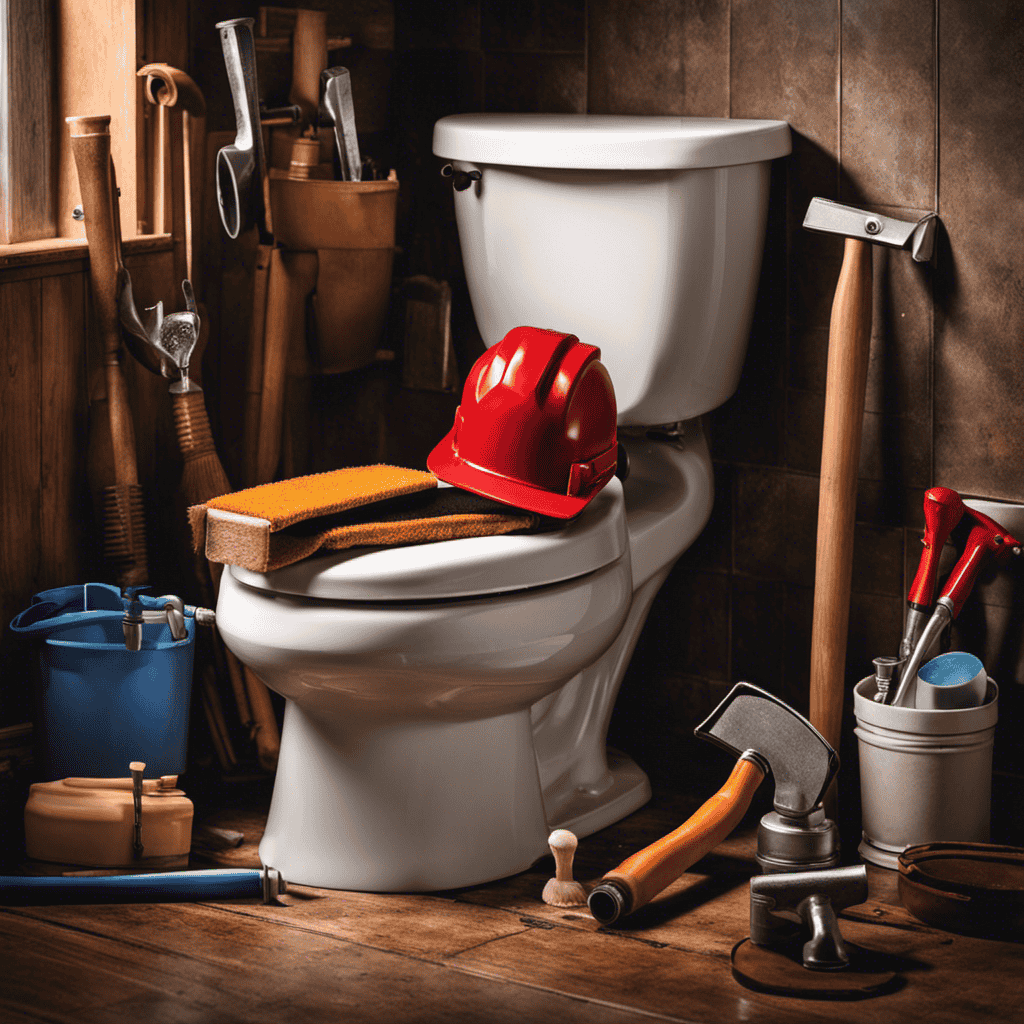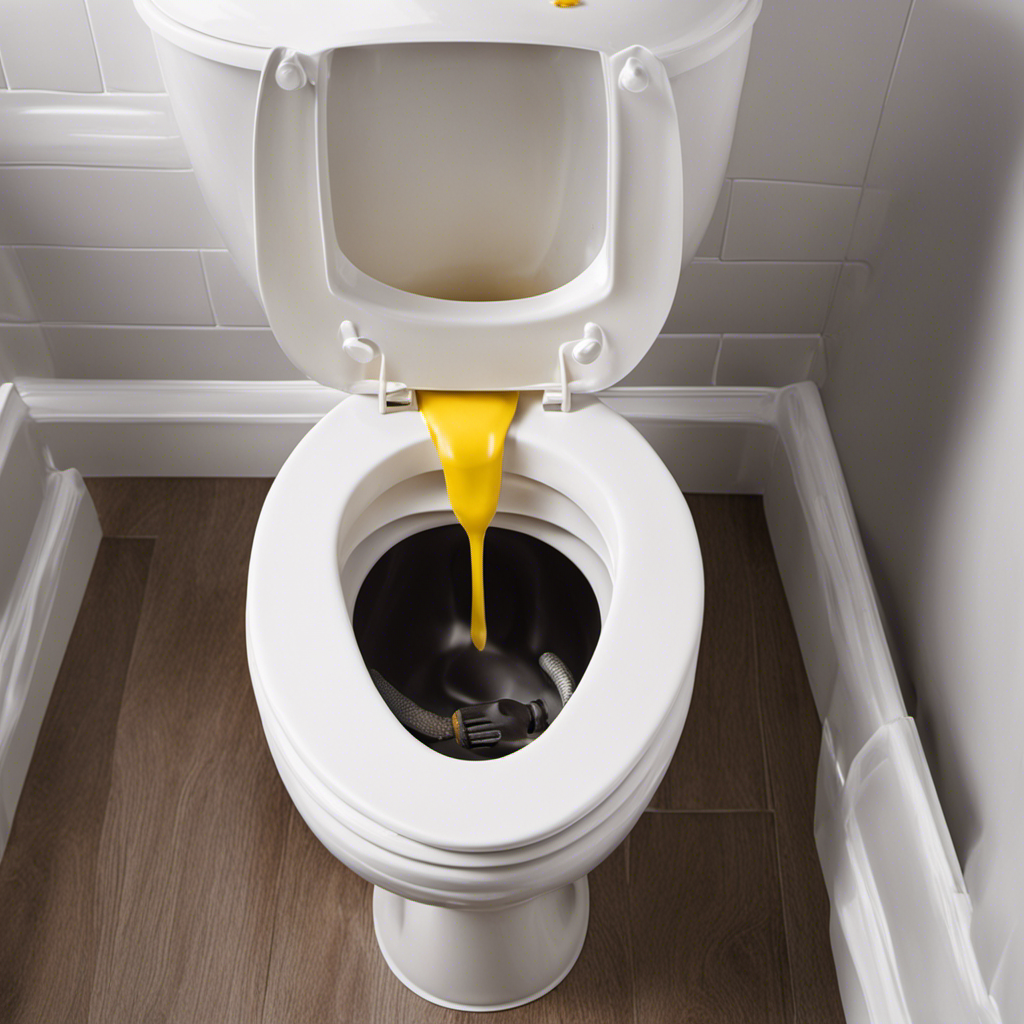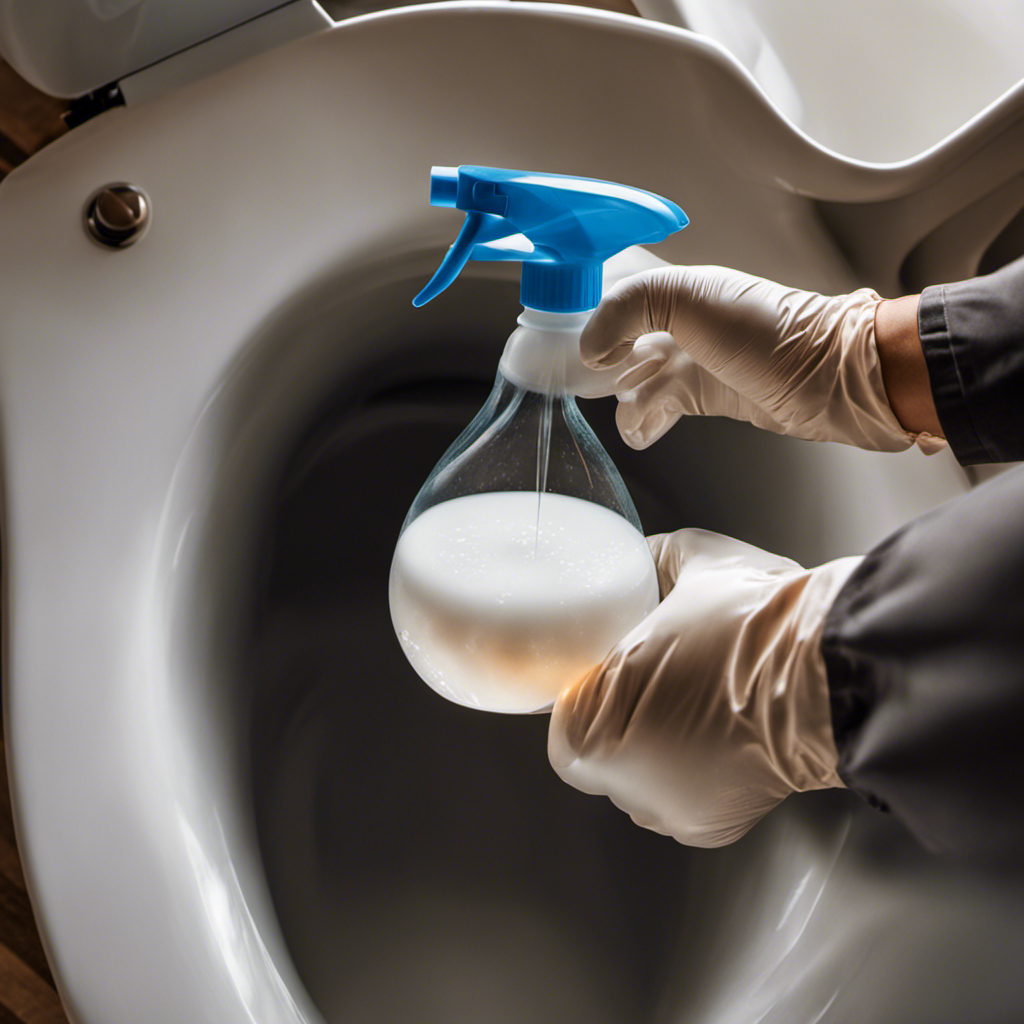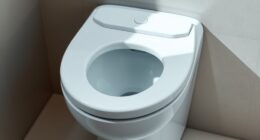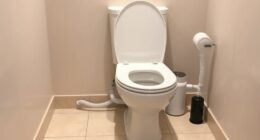As someone who has dealt with the dreaded toilet overflow, I understand the panic and frustration it can cause.
Did you know that over 60% of households experience this plumbing nightmare at some point?
But fear not, for I am here to guide you through the process of defeating this common household problem.
From shutting off the water to mastering the art of plunging, I will provide you with the knowledge and techniques to restore order and functionality to your bathroom.
Let’s tackle this toilet trouble together!
Key Takeaways
- Locate and familiarize yourself with the main water shut-off valve in your home to quickly shut off the water supply in emergencies and prevent further damage and flooding risk.
- Use the right type of plunger, such as a flange plunger, and apply firm, downward pressure and pull up forcefully to unclog minor blockages. Use a snake for stubborn clogs, gently pushing it down the drain and rotating it to break up the blockage.
- Prevent future clogs by regularly cleaning the toilet bowl, avoiding flushing excessive toilet paper or non-flushable materials, and educating household members and guests about proper flushing habits.
- Act swiftly to minimize damage and ensure a clean environment in case of a toilet overflow. Use floor protection mats or absorbent pads, wipe up the floor promptly, and utilize odor-neutralizing products or enzymatic cleaners for proper odor elimination.
Water Shut-off: Essential Steps in Emergency Situations
I always make sure to know the essential steps for water shut-off in emergency situations. When it comes to toilet repair and dealing with plumbing emergencies, being prepared is crucial.
The first step is to locate the main water shut-off valve in your home. This valve is usually located near the water meter or where the main water line enters your house. Once you’ve found it, turn the valve clockwise to shut off the water supply.
It’s essential to familiarize yourself with this valve beforehand so that you can act quickly in case of an emergency. By shutting off the water supply, you can prevent further damage and minimize the risk of flooding.
Knowing these steps can make a significant difference when it comes to emergency plumbing situations.
Mastering the Art of Plunger Use: Techniques to Clear the Blockage
Once you’ve located the main water shut-off valve, you can now focus on mastering the art of plunger use to clear the blockage.
Preventing blockages is crucial to maintaining a functional and hygienic toilet. When faced with a clogged toilet, troubleshooting techniques can save the day.
The first step is to ensure you have the right type of plunger. A flange plunger is ideal as it creates a better seal. To clear the blockage, place the plunger over the drain hole, ensuring it covers the entire area. Apply firm, downward pressure and then pull up forcefully. Repeat this motion several times until the water starts to drain.
Remember to be patient and persistent. If the blockage persists, it may be time to seek professional assistance.
Unclogging With a Snake: When Plunging Isn’t Enough
When faced with a stubborn clog that refuses to budge, sometimes a plunger just won’t cut it. That’s when it’s time to bring out the snake, a powerful tool designed to navigate the twists and turns of your pipes and break up the toughest blockages.
With the right technique, using a snake can be highly effective in unclogging drains and toilets, ensuring smooth flow and preventing future clogs.
Snake Vs. Plunger: Effectiveness
Using a plunger is usually more effective than using a snake to unclog a toilet. While both tools have their pros and cons, a plunger provides a more immediate solution for most clogs. Let’s compare the advantages and disadvantages of each:
| Snake | Plunger | Pros |
|---|---|---|
| Can reach deeper clogs | Creates a strong suction | Effective for minor clogs |
| Good for removing solid objects | Easy to use | Can be used on different types of toilets |
| Less messy than a plunger | Affordable | Doesn’t require much physical strength |
While snakes have their uses, a plunger is the go-to tool for most clogs. However, if you find yourself without a plunger, there are alternative methods to try. Hot water, dish soap, or a mixture of baking soda and vinegar can sometimes break up the clog. If all else fails, it may be time to call a professional plumber.
Now that we’ve discussed the pros and cons of using a snake versus a plunger, let’s move on to the proper snake technique for unclogging a toilet.
Proper Snake Technique
I’ve learned that it’s important to master the proper snake technique for unclogging a toilet when a plunger isn’t enough. When it comes to snake maintenance, there are a few key steps to follow to avoid pipe damage and ensure effective unclogging:
- Begin by inserting the snake into the toilet bowl, gently pushing it down until you feel resistance.
- As you rotate the snake clockwise, continue pushing it further into the drain, maintaining a steady but gentle pressure.
- Be careful not to force the snake too aggressively, as this can cause damage to the pipes.
- If you encounter any stubborn clogs, try wiggling the snake back and forth to break up the blockage.
By following these steps, you can effectively unclog your toilet without causing any harm to your pipes.
Now that we’ve covered the proper snake technique, let’s move on to discussing ways to prevent future clogs.
Preventing Future Clogs?
To prevent future clogs, I suggest regularly cleaning the toilet bowl and avoiding flushing items that can easily cause blockages, such as excessive toilet paper or non-flushable materials. By following these simple maintenance tips, you can keep your toilet running smoothly and prevent the dreaded overflow.
Maintaining a clean toilet bowl not only improves the overall hygiene but also reduces the chances of clogs. Additionally, being mindful of what you flush down the toilet can save you from unnecessary trouble. The table below highlights some common items that should never be flushed down the toilet. Remember, prevention is key when it comes to avoiding clogs and ensuring a hassle-free experience.
Now, let’s move on to removing obstructions: tackling common culprits of toilet overflow.
Removing Obstructions: Tackling Common Culprits of Toilet Overflow
I know how frustrating it can be to deal with a toilet overflow caused by those pesky obstructions. But fear not! With a little know-how and some DIY unclogging techniques, you can easily tackle the common culprits of toilet overflow.
Here are some tips to help you prevent clogs and keep your toilet flowing smoothly:
-
Proper Flushing Habits:
-
Teach everyone in your household to only flush toilet paper and human waste.
-
Remind guests to avoid flushing items like wipes, cotton balls, and feminine products.
-
Regular Maintenance:
-
Use a plunger to clear minor clogs.
-
Consider using a drain snake or auger for more stubborn blockages.
Remember, prevention is key! By following these simple steps and being mindful of what goes down your toilet, you can save yourself the headache of dealing with a messy overflow.
Happy unclogging!
Floor Clean-up: Restoring Order After a Toilet Disaster
Luckily, I quickly grabbed some towels and promptly began wiping up the floor, so order was restored after the toilet disaster.
When faced with a toilet overflow, it’s crucial to act swiftly to minimize damage and ensure a clean environment.
To protect the floor from further damage, consider using floor protection mats or absorbent pads. These products are designed to contain and absorb liquids, preventing them from seeping into the floor and causing long-term damage.
Additionally, proper odor elimination is essential to maintain a pleasant environment. Utilize odor-neutralizing products or enzymatic cleaners specifically formulated for eliminating toilet odors. These products work by breaking down the odor-causing compounds, effectively eliminating unpleasant smells.
Disinfection of Area: Ensuring a Hygienic Environment
Using disinfectant wipes, I thoroughly clean all surfaces in the area to ensure a hygienic environment. Proper sanitation is crucial in maintaining a clean and safe space. Regular cleaning not only removes dirt and grime but also eliminates harmful bacteria and viruses that can cause illness.
Here are two key steps to ensure proper sanitation:
-
Clean all surfaces: Wipe down countertops, sinks, and toilet seats with disinfectant wipes. Pay close attention to high-touch areas like door handles and light switches.
-
Dispose of waste properly: Empty trash bins regularly and ensure that waste is disposed of in designated containers. This prevents the spread of germs and keeps the area clean and odor-free.
By following these steps, we can create an environment that promotes health and safety.
Now, let’s move on to the next section: toilet functionality check: assessing the damage and restoring normal operation.
Toilet Functionality Check: Assessing the Damage and Restoring Normal Operation
After inspecting the toilet, I discovered three major issues that need immediate attention in order to restore normal functionality.
Firstly, there’s a significant clog in the drain pipe, causing water to accumulate and preventing proper flushing.
Secondly, the fill valve is malfunctioning, leading to inadequate water supply and inefficient flushing.
Lastly, the flapper valve is worn out, resulting in constant water leakage and a continuous running toilet.
To assess the damage and restore functionality, it’s crucial to address these issues promptly. Clearing the clog, replacing the fill valve, and installing a new flapper valve will help restore the toilet’s normal operation. By taking these steps, we can ensure that the toilet functions properly, preventing any inconvenience or potential damage.
Now, let’s move on to the next section, where we’ll discuss leak inspection and venting, addressing potential issues and improving airflow.
Leak Inspection and Venting: Addressing Potential Issues and Improving Airflow
When it comes to leak inspection and venting, there are a few key points to consider.
Firstly, it’s important to identify any hidden leaks in the plumbing system, as even small leaks can lead to significant damage over time.
Additionally, proper vent pipe installation is crucial for maintaining proper airflow and preventing issues like sewer gas buildup.
Lastly, improving bathroom ventilation can help remove excess moisture from the air, reducing the risk of mold and mildew growth.
Identifying Hidden Leaks
I’ve been searching for hidden leaks throughout the house, and I finally discovered one behind the bathroom wall. Leak detection is crucial to prevent water wastage and potential damage to your home. Here are some key points to consider:
-
Signs of hidden leaks:
-
Unexplained increase in water bill
-
Musty odors or mold growth
-
Discoloration or warping of walls or ceilings
-
Dampness or pooling of water in unexpected areas
-
Steps for leak detection:
- Check visible pipes for signs of leakage.
- Monitor water meter movement when all faucets are off.
- Utilize infrared cameras or moisture meters for hidden leaks.
Identifying and addressing hidden leaks can help conserve water and save you money.
Now, let’s transition into discussing the importance of proper vent pipe installation to ensure optimal airflow and prevent further issues.
Proper Vent Pipe Installation
To prevent potential issues and improve airflow, it’s important to ensure proper vent pipe installation. Proper vent pipe maintenance plays a vital role in the overall functioning of a plumbing system.
Vent pipes are responsible for removing harmful gases and odors from the plumbing system, allowing proper drainage and preventing clogs. However, if vent pipe installation isn’t done correctly, it can lead to various problems such as slow drainage, foul odors, and even water backups.
Troubleshooting vent pipe issues involves checking for obstructions, leaks, or damage to the pipes. Regular inspections and maintenance can help identify and address these issues before they escalate.
By ensuring proper vent pipe installation and maintenance, we can ensure efficient plumbing systems and a comfortable living environment.
Now, let’s move on to improving bathroom ventilation for even better air quality.
Improving Bathroom Ventilation
Sometimes, opening a window and using an exhaust fan can greatly improve bathroom ventilation and prevent mold growth. These simple steps not only enhance bathroom aesthetics but also play a vital role in reducing moisture levels.
Here are some key techniques to achieve better bathroom ventilation:
-
Install a high-quality exhaust fan: A properly functioning exhaust fan efficiently removes moisture-laden air, reducing the chances of mold and mildew growth.
-
Regularly clean the exhaust fan: Over time, dust and debris can accumulate on the fan blades, hindering its effectiveness. Clean the fan regularly to ensure optimal airflow.
-
Consider a window upgrade: If your bathroom lacks a window or has an old one, consider upgrading to a window with better insulation and ventilation features.
-
Utilize a dehumidifier: In particularly humid climates or during excessive moisture buildup, a dehumidifier can be a useful tool to maintain optimal moisture levels in the bathroom.
Frequently Asked Questions
How Do I Prevent a Toilet Overflow From Happening in the First Place?
To prevent a toilet overflow from happening in the first place, you can take some preventive measures and try DIY solutions.
It’s important to regularly check your toilet for any signs of clogs or blockages. Avoid flushing large amounts of toilet paper or other items that could cause a backup.
Additionally, installing a water pressure regulator can help prevent excessive water flow.
Can a Toilet Overflow Cause Damage to the Flooring or Walls?
A toilet overflow can cause significant damage to the flooring and walls of your home. If not properly addressed, the excess water can seep into the floor and walls, leading to mold and structural issues.
To clean up after a toilet overflow, start by turning off the water supply and mopping up the excess water. Then, thoroughly dry the affected area and disinfect it to prevent any bacteria or mold growth.
If water damage occurs, it’s important to contact professionals to assess and repair any structural or cosmetic issues.
Is It Necessary to Call a Professional Plumber if I Am Unable to Fix the Toilet Overflow Myself?
If you find yourself unable to fix a toilet overflow, it may be necessary to call a professional plumber.
While there are DIY fixes for toilet overflows, such as unclogging the drain or adjusting the float valve, some problems may require more expertise.
A professional plumber can accurately diagnose the issue and provide the most effective solution.
Additionally, they can offer advice on toilet overflow prevention to avoid future problems.
How Long Does It Usually Take to Unclog a Toilet Using a Plunger?
Using a plunger to unclog a toilet can typically take anywhere from a few minutes to several attempts. The time it takes depends on the severity of the clog and your proficiency with the plunger.
It’s important to use proper plunging techniques, such as creating a good seal and applying firm, consistent pressure.
Common causes of toilet clogs include excessive toilet paper, foreign objects, or a buildup of waste and debris. Being mindful of what you flush can help prevent future clogs.
What Are Some Common Signs of a Clogged Toilet That May Lead to an Overflow?
When it comes to a clogged toilet, recognizing the warning signs is crucial to avoid a messy overflow. Some common causes include excessive toilet paper, foreign objects, or a buildup of waste.
To safely unclog without causing an overflow, start by using a plunger or a toilet auger. Apply firm, steady pressure and repeat as necessary. Remember, patience is key.
If the problem persists, it’s best to call a professional plumber for assistance.
Conclusion
In conclusion, knowing how to handle a toilet overflow can save you from a messy and inconvenient situation. By following the steps outlined in this article, such as shutting off the water, using a plunger or snake, and addressing common culprits of blockages, you can successfully handle the issue.
For example, imagine a scenario where a family is hosting a dinner party and their toilet suddenly overflows. By quickly shutting off the water and using a plunger, they’re able to resolve the problem before guests arrive.

